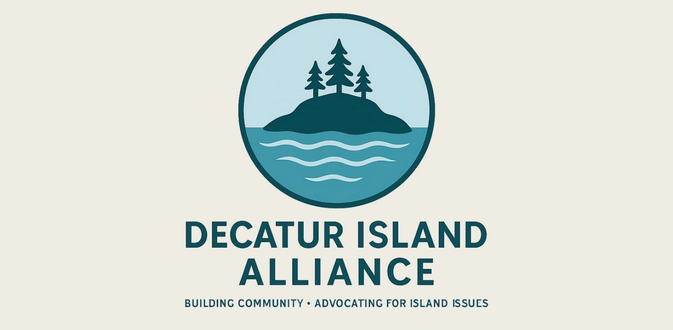At their regular meeting on March 3, the Eastsound Planning Review Committee (EPRC) weighed in on the most recent acquisition by OPAL, the “Baker House” that was moved last weekend from the west side of the airport to Oberon Meadows.
OPAL Director Lisa Byers came before the review board with Jeanne Beck, OPAL’s first Executive Director and currently OPAL project manager, to review the Oberon Woods redesign of the lot configurations. Byers said, “One conundrum to figure out, with this designation in Eastsound, is the 10-foot side setbacks required.” Byers said that better use of the yard space for Oberon Meadows homeowners would result with the reconfiguration.
She proposed using a binding site plan to give “more flexibility allowing for better yards.” (Binding site plans are used on the developments of OPAL’s Wild Rose Meadow and Homes for Islanders’ North Beach Road construction).
In the following discussion, a binding site plan was defined as a provision within the code like a planned unit development in which certain promises, such as building location, are guaranteed.
EPRC committee members were generally in favor of the changed siting. Byers and Beck said that the process of moving the Baker house to Oberon Woods went very smoothly, working with the county and with Nichol Brothers, the movers. In addition, Byers noted that the house was “Well built with full dimensional lumber and well-maintained,” and that OPAL had “a receiving property — not a bad premise for us moving forward.”
Clean Water Projects
Julie Thompson of Community Development and Planning and Jeff Hanson of the County Marine Resources Committee presented information about the Clean Water Projects for Fishing Bay and Ship Bay Basins, as part of the “Managing Growth in Island Communities Project.”
These projects target the 2,238 acres of the Fishing Bay/Ship Bay basin on Orcas Island and 3,400 acres of WestcottBay/Garrison Bay on San Juan Island, and are funded by San Juan County””($358,211) and the Environmental Protection Agency’s Puget Sound Watershed Management Assistance Program ($696,184).
Other partners in the venture are county Public Works, Health and Community Serices Marine Resources Committee, and the San Juan Islands Conservation District.
The objectives are to help property owners improve the function of the local environment and manage growth impacts such as stormwater runoff, pollution, erosion and septic systems; and to provide information about managing growth.
Thompson said the project is “aimed at managing stormwater and making sure it’s clean when it enters Fishing Bay/Ship Bay. It’s not just a shoreline project, because of the effect of upland water runoff, [it affects] commercial and residential property owners to keep the waters clean and make their property more valuable and easier to manage.”
It is expected that these goals will be met through:
- Technical assistance to property owners through workshops, site visits and cost sharing
- Building expertise of county staff and long-term funding opportunities
- Incorporation of low impact development policies into county laws
- Construction of an engineered wetland in Eastsound to manage stormwater runoff
- An international (U.S. Canada) workshop to “showcase management approaches and tools being used in island communities around the Salish Sea.”
The project will also coordinate with the Green Shores for Homes program (Washington Sea Grant, city of Seattle, Archipelago, Inc., Islands Trust and other organizations).Thompson noted that the County match of $358,211 is allocated mostly to the stormwater facility in Eastsound and the storm drain installed in late 2010.
Jeff Hanson asked the EPRC for their assistance in identifying local focus groups and publicizing the Clean Water Project workshops and information on such topics as low impact development, rain gardens, shoreline erosion control measures and technical site visits.
In information circulated at the meeting, County staff ask for EPRC advice and assistance specifically to:
- Identify prime project sites in Eastound for low-impact development, along with potential synergies to accomplish these projects
- Advise on outreach, including naming the project
- Assist with ideas and information to meet the project objectives
- Assist with evaluating the effectiveness of the project and have a representation make a report at the trans-boundary conference in 2013
The EPRC was told there is about $35,000 in cost-share money, which could be used for expenses such as installing risers in septic systems.
Organizers of the project plan to meet the fourth Thursday of the month at 10 a.m. in council conference room, adjourning at noon.
County Council reports
County Council member Richard Fralick (Orcas West) announced an Orcas Town Hall on Thursday, March 10 from 4 to 6 p.m. in the Eastsound Fire Hall.
Fralick said that in order for the County budget for 2011 to be balanced, “substantive changes to form of county government to make sustainable” are needed.
County Council member Patty Miller (Orcas West), who is now chairing the Council Subcommittee on Solid Waste, said that the current structure of tipping fees and an excise tax doesn’t cover capital costs for three transfer or drop box facilities. The feasibility of route-collected waste (the curbside model) will be explored.
Miller further noted that the current waste management contract expires in 2012, with costs expected “to go up dramatically.” Miller said the council is aware that route collection is “not the service the citizens want; the public would like to retain facilities [on Orcas, Lopez and San Juan Islands].”
The subcommittee plans to go out to voters in November, “with an alternative to maintain some facilities and deliver as many services as we can. The details are not known, it will take a lot of work to figure out what that will look like, “ Miller said.
EPRC member Bob Connell asked if the affect of charging for recycling had been determined, and Fralick responded that that impact is not yet known.
Miller said that there had been no conversation about closing the Exchange on Orcas Island. “We understand citizens would like those services retained and we’ll be looking at every possible way to retain them.”
Fralick then reported on the Critical Areas Ordinanace (CAO) and Shoreline Management Plan (SMP) update processes.
Most recently, the County Council held a joint meeting with the Planning Commission to review the information provided. “The [CAO] process is moving well along, we hope to have a draft in April, and… to adopt the CAO update by the end of the year.
“The SMP process has started and contracts [have been made] with watershed companies.” Fralick said that the “County Summit,” held March 2 on Orcas to explain process and timelines to citizens, had a “disappointing turnout; not a broad spectrum of the community.
“We had an engaged audience on Lopez the night before… the split was about the same, but there was a more centrist element and we had a good dialogue,” Fralick said.
Project Review
The committee reviewed plans for the Lopez Vineyard and Tasting Room, which is planned for the building formerly occupied by a hair salon and most recently, an upholstery store. The observed that unless the remodel of the property converts storage space to retail space, there would be no change of use.
They also noted that parking requirements should be noted in county officials’ plan review.
**If you are reading theOrcasonian for free, thank your fellow islanders. If you would like to support theOrcasonian CLICK HERE to set your modestly-priced, voluntary subscription. Otherwise, no worries; we’re happy to share with you.**







